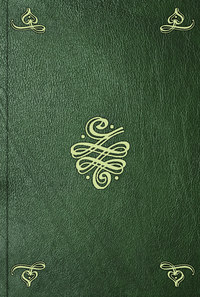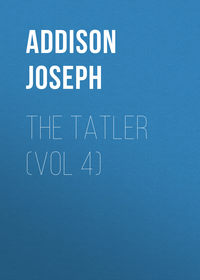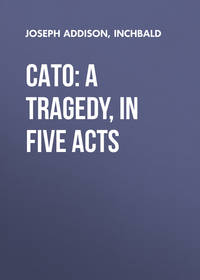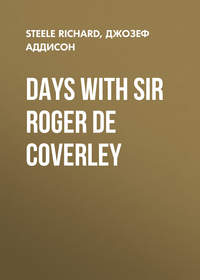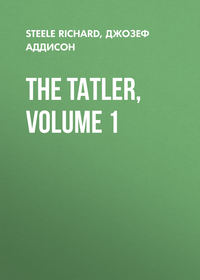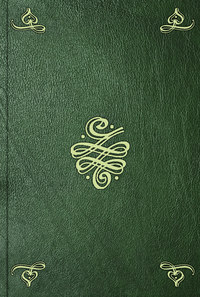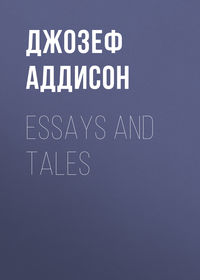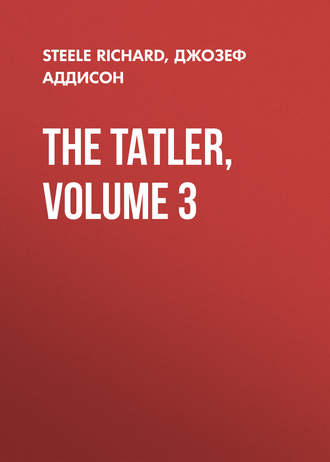 полная версия
полная версияThe Tatler, Volume 3
256
See No. 129.
257
Essay xii., "Of Boldness."
258
See No. 166.
259
See Nos. 157, 160.
260
Now Whitehall Gardens, between Parliament Street and the Thames. There Pepys had the pleasure of seeing Lady Castlemaine in 1662: "In the Privy Garden saw the finest smocks and linen petticoats of my Lady Castlemaine's, laced with rich lace at the bottom; and did me good to look at them."
261
See No. 60.
262
The four kings were Iroquois chiefs who had been persuaded by adjacent British colonists to come and pay their respects to Queen Anne, and satisfy themselves of the untruth of the assertion made by the Jesuits, that the English and all other nations were vassals to the French king. They were said also to have been told that the Saviour was born in France and crucified in England. The names of the kings, according to Boyer's "Annals," were: Tee Yee Neen Ho Ga Prow, and Sa Ga Yean Qua Prah Ton, of the Maquas; Elow Oh Kaom, and Oh Nee Yeath Ton No Prow, of the River Sachem, and the Ganajoh-hore Sachem. They had an audience of the Queen on April 19, 1710, and were afterwards entertained by the Lords Commissioners of the Admiralty, the Duke of Ormonde, &c., until their departure for Boston on the 8th of May. See Addison's paper in the Spectator, No. , and Swift's remark upon it in the "Journal to Stella," April 28, 1711. A concert at York Buildings on May 1, 1710, "for the entertainment of the Emperor of the Mohocks and the three Indian kings," was advertised in No. 165 of the Tatler. The kings were lodged at the Two Crowns and Cushion, the house of an upholsterer in Covent Garden, probably Thomas Arne, the father of Dr. Thomas Arne the musician, and Mrs. Cibber, the actress. The following advertisement appeared at the end of No. 250, dated Nov. 14, 1710, and with some variation was reprinted in Nos. 253, 256, and 267 of the original edition: "This is to give notice, that the metzotinto-prints, by John Simmonds, in whole lengths, of the four Indian kings, that are done from the original pictures drawn by John Verelst, which her Majesty has at her palace at Kensington, are now to be delivered to subscribers, and sold at the Rainbow and Dove, the corner of Ivy Bridge in the Strand."
263
Arne's shop.
264
"Last Sunday Mr. Francis Eustace committed a most barbarous murder on the body of his wife, by giving her seven or eight stabs with his sword, of which she died instantly. He jumped out of the window, and falling on a palisado pale, tore his legs and thighs in such a manner that he was forced to have them dressed by the surgeon, who is since sent to Newgate for letting him escape, and a proclamation is issued out for apprehending him" (British Mercury, 1710).
265
Fence.
266
Hence the phrase, "a knock-down argument."
267
Horace, 1 Od. v. 1.
268
See 1 Od. xxii. 23:
"Dulce ridentem Lalagen amabo,
Dulce loquentem."
269
Horace, 1 Od. ix. 24.
270
See Nos. 125, 127, 175.
271
Two of the numerous astrologers who lived in Moorfields.
272
During the first half of the eighteenth century the walls of Bedlam were made use of by dealers in second-hand books.
273
The waiter; see No. .
274
Douay capitulated on the 25th of June, after a fifty-four days siege, which cost the Allies eight thousand men. Two English regiments were cut to pieces at a sortie made by the besieged French troops. Two years later Douay was recaptured by Villars.
275
Eucrates reminds us in some respects of Steele himself.
276
Perhaps Cornelius Wood. See No. 144.
277
In writing of Aristæus, Steele seems to have had Addison in his mind. His friend had recently left London for Ireland.
278
See No. .
279
Writer of news.
280
"Epist." iii. 21.
281
Livy, ii. 12.
282
Mrs. Manley's "Memoirs of Europe … by the translator of the 'New Atalantis.'" See Nos. , 63.
283
"–Nullum memorabile nomen
Fœminea in pœna est."—"Æneid," ii. 583-4.
284
"Don Quixote," Part I. chap. i.
285
See Nos. 155, 160.
286
In the Spectator, No. 251, Addison applies the word to a crazy person: "A crack and a projector."
287
Writers of newspapers.
288
The Postman was edited by a French Protestant named Fontive, whom Dunton describes as "the glory and mirror of news-writers; a very grave, learned, orthodox man."
289
Albergotti was then holding Douay for Lewis XIV.
290
See No. . The news-letter was printed to imitate handwriting.
291
Cf. "Macbeth," act iii. sc. 4:
"Stand not upon the order of your going,But go at once!"292
A réchauffé.
293
See No. .
294
See No. 67.
295
The correct reading is, "O, qui me gellidis in vallibus," &c.
296
"Epist." ii. 17.
297
Thomas Smith, who voted against Steele's expulsion, was member for the borough of Eye, and may have been the person who wrote this letter, to which the initials of his name are subscribed. In the preface to the Examiner, the first number of which was published Aug. 3, 1710, there is the following passage: "All descriptions of stage-players and statesmen, the erecting of greenhouses, the forming of constellations, the beaus' red heels, and the furbelows of the ladies, shall remain entire to the use and benefit of their first proprietor."
The description of stage-players and statesmen, here mentioned, is an allusion to Downes' letter. See No. 193.
298
"Alieni appetens, sui profusus" ("Bell. Cat." cap. i.).
299
See No. 142.
300
Steele's father, Richard Steele, was a Dublin solicitor. His mother, whose maiden name was Elinor Sheyles, had married Thomas Symes, of Dublin, as her first husband.
301
Thackeray has compared the treatment of Death by Swift, Addison, and Steele. After speaking of Addison's "lovely serenity" and Swift's "savage indignation," he turns to Steele: "The third, whose theme is Death, too, and who will speak his word of mortal as Heaven teaches him, leads you up to his father's coffin, and shows you his beautiful mother weeping, and himself an unconscious little boy wondering at her side. His own natural tears flow as he takes your hand, and confidingly asks for your sympathy; 'See how good and innocent and beautiful women are,' he says, 'how tender little children! Let us love these and one another, brother—God knows we have need of love and pardon!'" ("English Humourists," 1864, 158-9).
302
The unsuspecting.
303
"Notice is hereby given, that 46 hogsheads and one half of extraordinary French claret will be put up to sale, at £20 per hogshead, at Garraway's Coffee-house in Exchange Alley, on Thursday the 8th instant, at three in the afternoon, and to be tasted in a vault under Messrs. Lane and Harrison's, in Sweething's Lane, Lombard Street, from this day till the time of sale," &c. (No. 181, Advertisement).
304
See No. .
305
Colley Cibber, actor and dramatist, was born in 1671. He was admirable alike as an actor of comic parts and a critic of acting, and some of his comedies are excellent. In 1714 Cibber became associated with Steele in the management of Drury Lane Theatre. After his retirement from the stage in 1733 he published his famous "Apology" (1740). He died in 1757. Steele wrote several times in his praise in the Spectator (Nos. 370, 546).
306
Sir Harry Wildair, in Farquhar's "Constant Couple."
307
Sir Novelty Fashion, in Cibber's "Love's Last Shift."
308
In this play, produced in 1705, Wilks was Sir Charles Easy; Cibber, Lord Foppington; and Mrs. Oldfield, Lady Betty Modish. In his "Apology" Cibber said that it was only just to place to the account of Mrs. Oldfield a large share of the favourable reception accorded to "The Careless Husband."
309
See Nos. 120, 122. "I remember Mr. Bickerstaff at the playhouse, and with what a modest, decent gravity he behaved himself" (Examiner, vol. iii. No. 46). This passage occurs in a notice of Addison's "Cato," where it is said that on the first night a crowd of silly people "were drawn up under the leading of the renowned Ironside, and appointed to clap at his signals.... The Spectator never appeared in public with a worse grace."
310
See Nos. , , 138.
311
See No. 129. In Lillie's "Letters sent to the Tatler and Spectator" (i. 56) there is a letter from "Orontes" to Mr. Bickerstaff, dated July 6, 1710, referring to this and to No. 190, in which the writer says: "You would do yourself a grand favour, if you would break off acquaintance with the Italian Pasquin, and not disturb yourself with principles which are as far above your thoughts as the probability of your discovering the philosopher's stone." A censor should not be among the factions.
312
See No. 118.
313
Handkerchiefs printed with pictures of Dr. Sacheverell.
314
The Pretender.
315
Dr. Sacheverell received many popular ovations while he was suspended from preaching: "Lest these brethren in iniquity [the Observator and the Review] should not prove sufficient to poison the nation, sow sedition plentifully, and ripen rebellion to a fruitful harvest of blood and rapine, a third person [the Tatler] who for a considerable time hath diverted the Town with the most useful and pleasing amusements our age ever produced, hath joined in the cry with them, in hopes, no doubt, that by his additional strength they shall become such a formidable Triumvirate that all opposition must fall before them, and the Church irresistibly submit to that fate which the other two have so long endeavoured to procure by their seditious popular harangues.... Our third gentleman is pleased to tell us, 'That great and popular actions,' &c. This is a subtle way to create jealousies and divisions amongst us, noways becoming the character of a gentleman, or an ingenuous education. Pray, sir, speak plain, and don't instil your poison secretly, and stab in the dark. What heroes in our service are treated with calumny? Who do you mean by your Hanno and Hannibal? All the nation owns and glories in the noble actions of our great Duke of Marlborough" (Moderator, No. 13, June 30 to July 3, 1710). The next number of the Moderator, No. 14, is upon the same subject, and is largely occupied with a discussion of the legal question mentioned in the Tatler, No. 190. The writer speaks of the brains of the common people, who are too apt to censure the actions of their superiors, as "set on work by a person who has gained their esteem by his learned Lucubrations." "They are assured that a gentleman of his bright parts and learning must be intimately acquainted with persons of the first rank and quality, from whom he learns these high and important secrets which he thus generously communicates to the world." If any one, therefore, pretends that the author's meaning is that the "Duke of Marlborough is likely to be ruined by the Lord Treasurer's converting to other uses that money which our Senate voted for our General's service, who is to be blamed for the vile aspersion?" Ministers should take care that the spreaders of such false reports shall know to their cost that the Act respecting false and slanderous news is still in force.
316
The conclusion of Pasquin's letter alludes to the following allegorical piece, the publication of which was just then recent: "The History of Hannibal and Hanno, &c., collected from the best authors, by A. M., Esq." It is reprinted in "The Life and Posthumous Writings" of Arthur Maynwaring, 1715. See No. 190.
317
See No. 65.
318
See No. 179.
319
Virgil, "Georg." ii. 488 ("In vallibus Hæmi").
320
"Othello," act iii. sc. 4.
321
"Othello," act iii. sc. 3.
322
See Nos. , 71, 157, 167.
323
See No. 134.
324
See No. .
325
See No. .
326
See No. 185.
327
It has been suggested that the latter part of this paper may refer to Dr. Gilbert Budgell and his son Eustace, Addison's cousin. (See "Grand Magazine," i. 391, seq.; and Cibber's "Lives of the Poets," vol. v.) On the death of his father in 1711, Eustace Budgell came into possession of an estate of £950 a year.
328
Swift may have been among those who protested at the introduction of politics into the Tatler (see No. 187), and Nichols thought that he was the writer of the letter signed "Aminadab" in this number. In June 1710, the fall of the Whigs was rapidly approaching.
329
Pasquin. See Nos. 129, 130, 187.
330
2 Sam. xvi. 13.
331
1 Kings ii. 36.
332
"The Tories happen now to have other work upon their hands, and are not at leisure to return the civilities that are paid them; however, having had the honour of a letter from the King of France … they have sent in their answer to me, and desire me to forward it; but I am at a loss how to do this, unless my brother the Tatler will convey it under his cover, for I protest I know no man in England but him that holds a correspondence with his Christian Majesty" (Examiner, No. 2, August 10, 1710).
333
In reply to this suggestion that the character of Polypragmon was meant for Harley, Steele said, in the Guardian, No. 53: "I drew it as the most odious image I could paint of ambition.... Whoever seeks employment for his own private interest, vanity, or pride, and not for the good of his prince and country, has his share in the picture of Polypragmon; and let this be the rule in examining that description, and I believe the Examiner will find others to whom he would rather give a part of it, than to the person on whom I believe he bestows it, because he thinks he is the most capable of having his vengeance on me.... I have not, like him, fixed odious images on persons, but on vices." To this the Examiner (vol. iv. No. 2) replied: "He would insinuate, that Timon and Polypragmon are general characters, and stand for a whole species, or, as he quaintly words it, for Knights of the Shire. If this be true, why did he not before now silence the industrious clamours of his party, who both in print and public conversation applied those characters to persons of the first rank, though without any regard to the rules of resemblance?" The writer of "Annotations on the Tatler," 1710, in the preface to the second part, regretted that Steele had become a politician, and said, in allusion to Steele's experiments in alchemy: "Turning statesman and drudging for the Philosopher's Stone, are toils not altogether unlike each other; buffeting with fire, labouring in smoke, wearing out of lungs, and tiring oneself with expectation, are misfortunes common to both these projects; 'tis converting real gold to dross, out of a prospect of converting dross into real gold."
334
A burlesque of Lee's "Rival Queens; or, the Death of Alexander the Great," by Gibber, called "The Rival Queans; or, the Humours of Alexander the Great," was acted at Drury Lane in 1710, but not printed until 1729.
335
An adaptation of Beaumont and Fletcher's comedy, by the Duke of Buckingham, 1682.
336
The authorship of the greater part of this paper is uncertain; see note on next page.
337
"Reddere" (Horace).
338
See No. .
339
See Nos. 120, 122. In the continuation of the Tatler which Swift and Harrison conducted (No. 28, March 24, 1710-11) there is this passage: "The person produced as mine in the playhouse, last winter, did in no wise appertain to me. It was such a one, however, as agreed well with the impression my writings had made, and served the purpose I intended it for: which was to continue the awe and reverence due to the character I was vested with, and at the same time to let my enemies see how much I was the delight and favourite of this town," &c.
340
This letter, in ridicule of Harley's newly formed Ministry, has been attributed to the joint authorship of Anthony Henley (see No. ) and Temple Stanyan. Harley is supposed to be the gentleman referred to in the letter, and Downes, it has been suggested, is Thomas Osborne, first Duke of Leeds. Steele expressly disavowed responsibility for the letter from Downes the prompter. In No. 53 of the Guardian he wrote: "Old Downes is a fine piece of raillery, of which I wish I had been author. All I had to do in it, was to strike out what related to a gentlewoman about the Queen, whom I thought a woman free from ambition, and I did it out of regard to innocence." And in the Preface to the Tatler, he said that this letter was by an unknown correspondent. A writer in the Examiner (vol. iv. No. 2) mentions Old Downes among the sufferers of figure under our author's satire. The same writer, or another in the same paper, expresses himself in the following words: "Steele broke his own maxim for trifles in which his country had no manner of concern; and by entering into party disputes, violated the most solemn repeated promises and that perfect neutrality he had engaged to maintain. As a proof that I did not wrong him, he now openly takes upon himself Downes' letter, by wishing the raillery (as he calls it) were his own." In the "Essays Divine, Moral, and Political" (1714), p. 42, Swift is made to say, "I advised him [Steele] to the publishing that letter from Downes the prompter, which was the beginning of his ruin, though I here declare I did not write it." Forster ("Biographical Essays," 3rd ed.) concludes that this fictitious letter was certainly by Mainwaring himself. In the "Journal to Stella" (Oct. 22, 1710), Swift wrote: "He [Steele] has lost his place of Gazetteer, three hundred pounds a year, for writing a Tatler, some months ago, against Mr. Harley, who gave it him at first, and raised the salary from sixty to three hundred pounds." See also Swift's "The Importance of the Guardian considered."
341
John Downes was prompter to "The Duke's Servants" until 1706. In 1708 he published his valuable "Roscius Anglicanus, or an Historical Review of the Stage."
342
Christopher Rich, who began life as an attorney. See Nos. , 99.
343
A farce by Nahum Tate, 1685.
344
See No. .
345
The theatre built by Betterton and his friends in 1695, in Portugal Row, Lincoln's Inn Fields, was pulled down and rebuilt by Christopher Rich in 1714. The Roman Catholic Church here referred to was in Duke (now Sardinia) Street, on the west side of the square.




